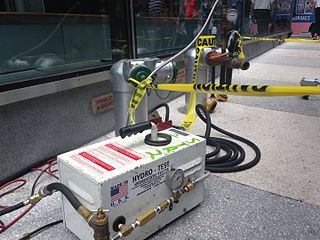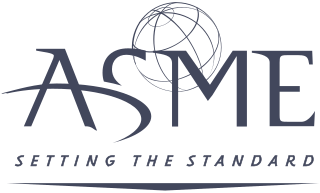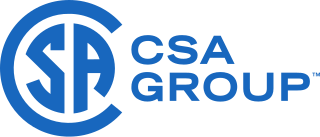
A safety valve is a valve that acts as a fail-safe. An example of safety valve is a pressure relief valve (PRV), which automatically releases a substance from a boiler, pressure vessel, or other system, when the pressure or temperature exceeds preset limits. Pilot-operated relief valves are a specialized type of pressure safety valve. A leak tight, lower cost, single emergency use option would be a rupture disk.

A hydrostatic test is a way in which pressure vessels such as pipelines, plumbing, gas cylinders, boilers and fuel tanks can be tested for strength and leaks. The test involves filling the vessel or pipe system with a liquid, usually water, which may be dyed to aid in visual leak detection, and pressurization of the vessel to the specified test pressure. Pressure tightness can be tested by shutting off the supply valve and observing whether there is a pressure loss. The location of a leak can be visually identified more easily if the water contains a colorant. Strength is usually tested by measuring permanent deformation of the container.

The American Society of Mechanical Engineers (ASME) is an American professional association that, in its own words, "promotes the art, science, and practice of multidisciplinary engineering and allied sciences around the globe" via "continuing education, training and professional development, codes and standards, research, conferences and publications, government relations, and other forms of outreach." ASME is thus an engineering society, a standards organization, a research and development organization, an advocacy organization, a provider of training and education, and a nonprofit organization. Founded as an engineering society focused on mechanical engineering in North America, ASME is today multidisciplinary and global.

A pressure vessel is a container designed to hold gases or liquids at a pressure substantially different from the ambient pressure.

The CSA Group is a standards organization which develops standards in 57 areas. CSA publishes standards in print and electronic form, and provides training and advisory services. CSA is composed of representatives from industry, government, and consumer groups.

The presence of the logo on commercial products indicates that the manufacturer or importer affirms the goods' conformity with European health, safety, and environmental protection standards. It is not a quality indicator or a certification mark. The CE marking is required for goods sold in the European Economic Area (EEA); goods sold elsewhere may also carry the mark.

A boilermaker is a tradesperson who fabricates steels, iron, or copper into boilers and other large containers intended to hold hot gas or liquid, as well as maintains and repairs boilers and boiler systems.
The Pressure Equipment Directive (PED) 2014/68/EU of the EU sets out the standards for the design and fabrication of pressure equipment generally over one liter in volume and having a maximum pressure more than 0.5 bar gauge. It also sets the administrative procedures requirements for the "conformity assessment" of pressure equipment, for the free placing on the European market without local legislative barriers. It has been mandatory throughout the EU since 30 May 2002, with 2014 revision fully effective as of 19 July 2016. The standards and regulations regarding pressure vessels and boiler safety are also very close to the US standards defined by the American Society of Mechanical Engineers (ASME). This enables most international inspection agencies to provide both verification and certification services to assess compliance to the different pressure equipment directives. From the pressure vessel manufactures PED does not generally require a prior manufacturing permit/certificate/stamp as ASME does.
Welder certification, is a process which examines and documents a welder's capability to create welds of acceptable quality following a well defined welding procedure.

Product certification or product qualification is the process of certifying that a certain product has passed performance tests and quality assurance tests, and meets qualification criteria stipulated in contracts, regulations, or specifications.
The Air Movement and Control Association International, Inc. (AMCA) is an American trade body that sets standards for Heating, Ventilation and Air Conditioning (HVAC) equipment. It rates fan balance and vibration, aerodynamic performance, air density, speed and efficiency.
Maximum Allowable Operating Pressure (MAOP) is a pressure limit set, usually by a government body, which applies to compressed gas pressure vessels, pipelines, and storage tanks. For pipelines, this value is derived from Barlow's Formula, which takes into account wall thickness, diameter, allowable stress, and a safety factor.
The ASME Boiler & Pressure Vessel Code (BPVC) is an American Society of Mechanical Engineers (ASME) standard that regulates the design and construction of boilers and pressure vessels. The document is written and maintained by volunteers chosen for their technical expertise. The ASME works as an accreditation body and entitles independent third parties to inspect and ensure compliance to the BPVC.
ASME NQA-1 is an industry consensus standard created and maintained by the American Society of Mechanical Engineers (ASME). The latest edition was issued on June 30, 2022 (NQA-1-2022). However, the most commonly used version in the supply chain is NQA-1-2008 with the NQA-1a-2009 addendum. Any organization submitting an application for a new design are using the NQA-1-2015 edition. This is the case because these are the versions endorsed by the NRC.
The Massachusetts Executive Office of Public Safety and Security is a Commonwealth of Massachusetts organization whose focus is the protection of individuals, groups or environment issues which will, subsequently, affect individuals or groups health or well being. As an executive agency, the Office is managed by a Commissioner who is appointed by the Governor.
The Uniform Mechanical Code (UMC) is a model code developed by the International Association of Plumbing and Mechanical Officials (IAPMO) to govern the installation, inspection and maintenance of HVAC and refrigeration systems. It is designated as an American National Standard.

The Cyclone Waste Heat Engine (WHE) is a small steam engine developed to produce power from steam created from waste heat. It is an offshoot of the development of the Cyclone Mark V Engine by the company Cyclone Power Technologies of Pompano Beach, Florida. The original versions were designed by inventor Harry Schoell, founder of Cyclone Power Technologies and the later versions have been designed by the Ohio State University Center for Automotive Research (OSU-CAR).
ASME is a non-profit organization that continues to develop and maintains nearly 600 codes and standards in a wide range of disciplines. Some of which includes the Boiler and Pressure Vessel Code (BPVC), Elevators and Escalators, Piping and Pipelines, Bioprocessing Equipment (BPE), Nuclear Facility Applications (NQA), Process Performance Test Codes (PTC), and Valves, Flanges, Fittings and Gaskets (B16).
Canadian pressure laws, Acts, rules & regulations are enforced by provincial and territorial safety authorities. Unlike the United States where licensed professional engineers (PE) may stamp pressure equipment and pressure system/plant drawings in the non-nuclear sectors for construction, in Canada in general a professional engineer (P.ENG) who is not employed by a safety authority does not have that same right to stamp regulated pressure equipment or pressure system drawings for construction, and doing so may result in fines or professional license revocation, or jail time. The pressure safety design registration approval given by safety authority registrars in Canada is called a Canadian Registration Number (CRN). Pressure equipment must be registered in each province or territory where it will be used.
June Ling is a retired American mechanical engineer who worked for many years on standardization at the American Society of Mechanical Engineers (ASME).








